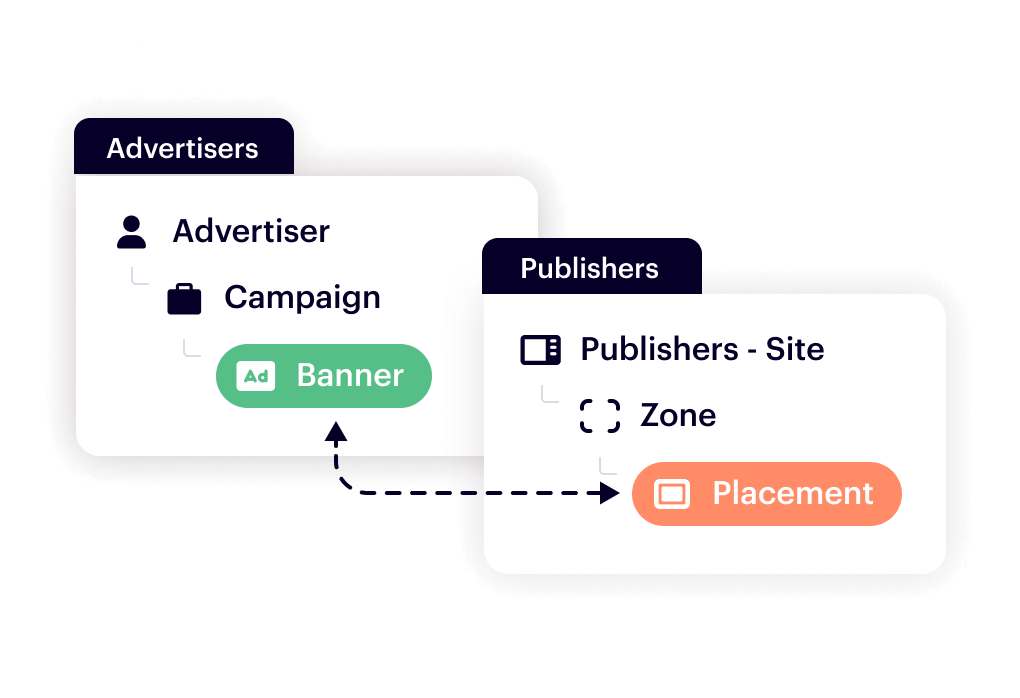Unleash the Full
Power of Your Ads
with Epom Ad Server
Gain autonomy in advertising with our ad serving software. Streamline ad operations and optimize your performance using a robust in-house solution.
Get instant access to your demo account, or start with a 14-day trial.

Proud partner of:




Ad Serving Platform Designed
for Every Business Success
Our enterprise-level ad server is tailored to fit the diverse needs of all
industry players to shine bright in the advertising universe.
Key Epom Ad Server Features
to Leverage Now
Welcome to the Epom ad serving platform product tour. Explore our core functionality
that will help you reach uncompromising precision and impact.





Ad Management & Customization
Lean on our solid technology for your ad strategy. Get a custom ad serving software that converts complex to simple with our developers by your side.
- Manage campaigns & placements
- Create custom partner accounts
- White-label or request custom development

Analytics & Optimization
Multiply your gains through the power of data. Generate detailed reports on your campaigns and utilize robust auto optimization tools to improve their results.
- Report featuring 40+ metrics and 10+ filters
- Track conversions and custom actions
- Apply CTR and CR optimization

Targeting & Priorities
Deliver your ads to the best audience segments. Use pre-set targeting attributes to narrow the user’s range or set up your own targeting based on unique publisher data.
- Apply 20+ targeting settings right away
- Set frequency capping and limits
- Re-distribute banner weights for optimal visibility

Supply-Side Platform
Sell via RTB to increase your fill rates. Automate inventory management with Epom SSP module for publishers and combine programmatic and direct deals in a single interface.
- Link your placements to DSP endpoints
- Bundle up our ad server with a white-label DSP
Boost Engagement with Ad
Creative Templates
Save time by using pre-coded rich media templates designed for ultimate user engagement.
Diversify your offerings with 30+ formats or request custom ones.
Ready to Try?
Launch Your First Demo Campaigns in Epom Ad Server

“We managed to increase the viewability of our streaming content by 231% during our partnership. With Epom templates, we quickly launch cross-channel video campaigns for our platform. The user experience of our ads is top-notch now.”
Explore Complete Epom
Ad Server Functionality
Our ad serving platform has more than 800+ customizable features on board.
Learn more about it’s core modules and their highlights.
Tree-Like Interface
Create publishers and advertisers in one dashboard.
Campaign Management
Launch fine-tuned direct campaigns.
Banner Placement
Manage placements on your website or app.
Roles & Permissions
Open sub-accounts for your partners or clients.
Platform White-Labeling
Rebrand our platform to resonate with your identity.
API and Custom Development
Integrate extras via API or order custom development.
Granular Reporting
Analyze 40+ metrics and get custom reports with 10+ filters.
eCPM Optimization
Maximize earnings from each placement.
CTR and CR Optimization
Get more clicks and conversions.
Performance Tracking
Track ad actions and collect performance data.
Real-Time Analytics
Enjoy intelligent data analysis.
Custom Targeting
Set up unique targeting variables based publisher data.
Frequency Capping
Prevent ad fatigue and ensure optimal exposure.
Banner Display Rules
Increase ad visibility with strategic banner prioritization.
Manual Weighing
Get refined control over ad creative distribution.
Waterfalls & Daisy Chaining
Define hierarchy or a specific sequence of ads to show.
Trusted by the Industry’s Flagmans
G2 Repeatedly Recognized
Epom Ad Server as the Top Performer
Discover why users love and praise our ad tech as the best one on the global market.
Do not take our word for it; check out what people say on G2.






"An effective tool if you need to control your traffic sources"
We've seen benefits from the robust ad-serving tool in monitoring traffic source quality. The platform helps us manage our advertising campaigns efficiently and create engaging ad units and formats ...
Read full review
Custom Ad Server Software
for Cross-Channel Advertising
Place your ads with the Epom ad serving tool anywhere your audience can be.
We can elevate your digital presence across all major ad channels.
Compare Epom Ad Server
to other solutions on the market
Choose smart, not hard! Be sure you make the right choice by analyzing all the pros and cons.
Wanna see a full comparison in one full-packed PDF?
Download nowFAQ
Epom ad server offers 4 pricing plans tailored for different purposes and businesses: Light, Growth, Pro, and Enterprise.
Monthly plans cost $250, $1000, and $2500 accordingly; the price for the Enterprise plan depends on your specific requests, so it is formed after you consult with the sales team.
Annual plans allow you to save 15% monthly, so the ad serving fees are lower in this case: $212/mo, $850/mo, $2125/mo. The enterprise plan still needs to be discussed in person with the sales team, but the discount is available too.
An ad server is an ad tech platform that allows publishers and advertisers to manage their ads, campaigns, and inventory with high precision. Ad servers were the first-ever advertising tools and are still used for direct deals and manual control over campaigns. Ad networks use the ad serving technology to match their clients in a single system and earn money on a margin set on a deal.
Ad serving technology is primarily used for direct deal management, meaning you have to know your partners in person and negotiate the costs of an ad placement before launching a campaign.
A demand-side platform (DSP) is a tool used for programmatic advertising, meaning the process happens here automatically, based solely on the advertiser’s targeting preferences and publisher’s inventory characteristics.
Thus, ad servers match the exact ads to placements, while DSPs match targeting to audiences. In the latter case, placement itself doesn’t play any significant role.
Depending on your needs and volumes, ad serving fees may range from free to thousands of dollars. The average typical fee for a hosted ad server is around $200-500. That’s for the basic package, while more advanced plans typically reach $1000-2000 in their pricing.
Epom offers cheap options starting from $212 for our Light plan and $850 for our Growth plan if you pay annually.
The ad serving technology offers you tons of opportunities to optimize your advertising strategy. The major benefits of using an ad server are complete control over your ad management, robust auto-optimization of your ad or placement performance, and a significant revenue boost if you run an advertising business.
Building the product from scratch gives you tremendous autonomy and control, although such a path is far from budget-friendly.
It may cost thousands for a super basic ad serving solution and millions for a sophisticated one. You’ll have to cover staff salaries, technical maintenance, hosting, and security expenses.
White-labeling can be an alternative to this. The technology is ready for you immediately: you just have to re-brand the platform as your own and customize the interface for your needs. Technical maintenance and updates stay on us. Meanwhile, you focus on growing your company.
Some of the best ad serving providers on the market include Google Ad Manager, Epom, AdButler, Kevel, AdGlare, and Revive, to list a few. All of them are different in terms of the companies they cater to, features, pricing, and overall product policies. You can check out our ad server platforms comparison to see which one might fit you best.
Reason 1: Ad servers are the industry’s golden standard for managing direct ad campaigns.
Reason 2 : Ad serving technology effectively improves performance and maximizes earnings from each ad placement.
If you’re:
- An advertiser who wants to run direct ad campaigns;
- A publisher who wants to link their ad placements with ads from demand partners;
- An ad network/agency who wants to match their clients’ demand & supply;
Then yes and yes, you need ad serving.
In simple terms, an ad server serves ads; this is called ad serving. The process is a staple of direct media buying – the type of ad deals where the publisher's and advertiser's ad servers connect with each other without any intermediaries.
Brands, publishers, ad networks/agencies – every business interested in direct media buying can benefit from the ad serving technology. It helps:
- Advertisers to structure their ad serving activities and decrease money lost due to a lack of data and human errors;
- Publishers to connect with multiple demand partners and manage mutual campaigns in one interface;
- Ad networks to match publishers and advertisers in a single dashboard, serve ads across different channels simultaneously, and monitor both publishers' and advertisers’ performance in real-time.
In a bundle, you use an ad server platform as a supply-side tool. SSP and DSP form a complete in-house programmatic stack, which means an automated, fast, and effortless connection of your advertisers to your ad placements.
An online advertising network is a business that matches the publisher’s inventory and advertiser’s demand and earns money from a deal margin.
Ad serving technology, on the other hand, is software that hosts information about ads and delivers advertising content to different digital platforms, websites, and mobile apps.
Ready, Set, Go!
Your Free Access to Epom is One Click Away


















